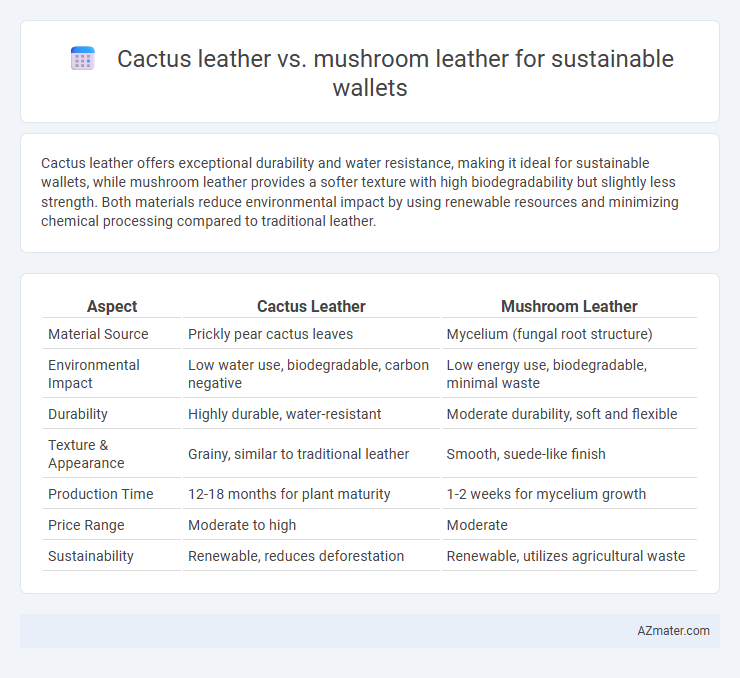Cactus leather offers exceptional durability and water resistance, making it ideal for sustainable wallets, while mushroom leather provides a softer texture with high biodegradability but slightly less strength. Both materials reduce environmental impact by using renewable resources and minimizing chemical processing compared to traditional leather.
Table of Comparison
| Aspect | Cactus Leather | Mushroom Leather |
|---|---|---|
| Material Source | Prickly pear cactus leaves | Mycelium (fungal root structure) |
| Environmental Impact | Low water use, biodegradable, carbon negative | Low energy use, biodegradable, minimal waste |
| Durability | Highly durable, water-resistant | Moderate durability, soft and flexible |
| Texture & Appearance | Grainy, similar to traditional leather | Smooth, suede-like finish |
| Production Time | 12-18 months for plant maturity | 1-2 weeks for mycelium growth |
| Price Range | Moderate to high | Moderate |
| Sustainability | Renewable, reduces deforestation | Renewable, utilizes agricultural waste |
Introduction to Plant-Based Leathers
Plant-based leathers, such as cactus leather and mushroom leather, offer eco-friendly alternatives to traditional animal leather by reducing environmental impact and promoting sustainability. Cactus leather is valued for its durability, water efficiency, and low carbon footprint, while mushroom leather, derived from mycelium, is biodegradable and rapidly renewable. Both materials provide innovative, cruelty-free options for sustainable wallets, appealing to environmentally conscious consumers seeking vegan and plant-derived products.
What is Cactus Leather?
Cactus leather is an innovative, eco-friendly material derived from mature prickly pear cactus leaves, offering a sustainable alternative to traditional leather. It is produced through a natural process that uses minimal water and no toxic chemicals, making it highly biodegradable and vegan-friendly. This material is gaining popularity in sustainable wallets due to its durability, softness, and reduced environmental footprint compared to mushroom leather, which is made from mycelium but often requires more intensive processing.
What is Mushroom Leather?
Mushroom leather, also known as mycelium leather, is an innovative sustainable material produced from the root structure of fungi, offering a biodegradable and eco-friendly alternative to traditional leather. It features a unique cellular structure that provides durability, water resistance, and a soft, flexible texture ideal for wallets. Compared to cactus leather, mushroom leather boasts faster growth cycles and lower water consumption, making it a more sustainable choice for environmentally conscious consumers.
Production Processes Compared
Cactus leather production relies on harvesting mature cactus leaves, which are cleaned, mashed, and dried to create durable, water-resistant material using minimal water and chemical inputs. Mushroom leather is derived from mycelium cultivation, where fungal networks grow on organic substrates in controlled environments, subsequently processed into flexible, biodegradable sheets with a lower carbon footprint. Both methods emphasize renewable resources and reduced environmental impact, but cactus leather requires less controlled growth conditions while mushroom leather offers faster material regeneration cycles.
Environmental Impact Analysis
Cactus leather production uses significantly less water, with estimates showing up to 90% reduction compared to traditional leather, thereby conserving vital aquatic resources. Mushroom leather, derived from mycelium, offers a rapid grow cycle and biodegradability, reducing landfill waste and carbon emissions associated with conventional leather. Both materials present lower environmental footprints, but cactus leather's minimal water usage and mushroom leather's renewable growth process highlight key advantages in sustainable wallet manufacturing.
Durability and Longevity
Cactus leather offers exceptional durability with its dense, fibrous structure, making it resistant to wear and tear for long-lasting wallets. Mushroom leather, derived from mycelium, provides a flexible yet sturdy material that ages gracefully but may require more careful maintenance to prevent damage. Both materials represent sustainable alternatives to traditional leather, with cactus leather generally excelling in longevity due to its tougher texture.
Look, Feel, and Aesthetics
Cactus leather showcases a smooth, matte finish resembling traditional leather with a subtle grain that appeals to minimalist aesthetics, while mushroom leather offers a more textured surface with natural variations that emphasize an organic, earthy vibe. The feel of cactus leather is supple yet firm, providing durability and a refined touch, whereas mushroom leather tends to be softer and more pliable, enhancing comfort and flexibility in wallet designs. Both materials deliver eco-friendly options with distinct visual and tactile qualities, catering to consumers seeking sustainable wallets without compromising style or durability.
Cost and Market Availability
Cactus leather offers a more affordable option compared to mushroom leather, with prices typically 20-30% lower due to its simpler processing methods and established supply chains. Mushroom leather remains less available in the market, often limited to niche brands and higher-end products, reflecting its more complex cultivation and production processes. Both materials support sustainability, but cactus leather's wider market presence makes it more accessible for eco-conscious wallet consumers.
Consumer Preferences and Trends
Cactus leather appeals to consumers seeking durability and a natural cactus-derived material with a lower water footprint, aligning with eco-conscious preferences. Mushroom leather attracts buyers focused on innovative biotechnology and biodegradability, highlighting its rapid growth and minimal environmental impact. Trends indicate growing demand for plant-based wallets with unique textures and certified sustainable practices, driving market adoption for both materials.
Which is Better for Sustainable Wallets?
Cactus leather offers durability, water resistance, and a lower environmental footprint due to its minimal water and pesticide requirements, making it an excellent choice for sustainable wallets. Mushroom leather, derived from mycelium, boasts biodegradability and rapid growth, contributing to a circular economy and reduced waste. While cactus leather excels in toughness and longevity, mushroom leather stands out for its eco-friendly decomposition, with the best option depending on user priorities between durability and full biodegradability.

Infographic: Cactus leather vs Mushroom leather for Sustainable wallet
 azmater.com
azmater.com